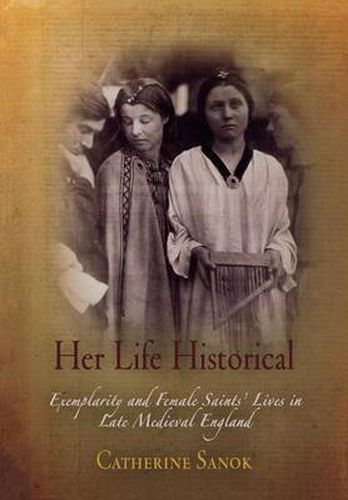Readings Newsletter
Become a Readings Member to make your shopping experience even easier.
Sign in or sign up for free!
You’re not far away from qualifying for FREE standard shipping within Australia
You’ve qualified for FREE standard shipping within Australia
The cart is loading…






This title is printed to order. This book may have been self-published. If so, we cannot guarantee the quality of the content. In the main most books will have gone through the editing process however some may not. We therefore suggest that you be aware of this before ordering this book. If in doubt check either the author or publisher’s details as we are unable to accept any returns unless they are faulty. Please contact us if you have any questions.
Her Life Historical offers a major reconsideration of one of the most popular narrative forms in late medieval England-the lives of female saints-and one of the period’s primary modes of interpretation-exemplarity. With lucidity and insight, Catherine Sanok shows that saints’ legends served as vehicles for complex considerations of historical difference and continuity in an era of political crisis and social change. At the same time, they played a significant role in women’s increasing visibility in late medieval literary culture by imagining a specifically feminine audience.
Sanok proposes a new way to understand exemplarity-the repeated injunction to imitate the saints-not simply as a prescriptive mode of reading but as an encouragement to historical reflection. With groundbreaking originality, she argues that late medieval writers and readers used religious narrative, and specifically the legends of female saints, to think about the historicity of their own ethical lives and of the communities they inhabited. She explains how these narratives were used in the fifteenth century to negotiate the urgent social concerns occasioned by political instability and dynastic conflict, by the threat of heresy and the changing status of public religion, and by new kinds of social mobility and forms of collective identity.
Her Life Historical also offers a fresh account of how women came to be visible participants in late medieval literary culture. The expectation that they formed a distinct audience for saints’ lives and moral literature allowed medieval women to surface in the historical record as book owners, patrons, and readers. Saints’ lives thereby helped to invent the idea of a gendered audience with a privileged affiliation and a specific response to a given narrative tradition.
$9.00 standard shipping within Australia
FREE standard shipping within Australia for orders over $100.00
Express & International shipping calculated at checkout
This title is printed to order. This book may have been self-published. If so, we cannot guarantee the quality of the content. In the main most books will have gone through the editing process however some may not. We therefore suggest that you be aware of this before ordering this book. If in doubt check either the author or publisher’s details as we are unable to accept any returns unless they are faulty. Please contact us if you have any questions.
Her Life Historical offers a major reconsideration of one of the most popular narrative forms in late medieval England-the lives of female saints-and one of the period’s primary modes of interpretation-exemplarity. With lucidity and insight, Catherine Sanok shows that saints’ legends served as vehicles for complex considerations of historical difference and continuity in an era of political crisis and social change. At the same time, they played a significant role in women’s increasing visibility in late medieval literary culture by imagining a specifically feminine audience.
Sanok proposes a new way to understand exemplarity-the repeated injunction to imitate the saints-not simply as a prescriptive mode of reading but as an encouragement to historical reflection. With groundbreaking originality, she argues that late medieval writers and readers used religious narrative, and specifically the legends of female saints, to think about the historicity of their own ethical lives and of the communities they inhabited. She explains how these narratives were used in the fifteenth century to negotiate the urgent social concerns occasioned by political instability and dynastic conflict, by the threat of heresy and the changing status of public religion, and by new kinds of social mobility and forms of collective identity.
Her Life Historical also offers a fresh account of how women came to be visible participants in late medieval literary culture. The expectation that they formed a distinct audience for saints’ lives and moral literature allowed medieval women to surface in the historical record as book owners, patrons, and readers. Saints’ lives thereby helped to invent the idea of a gendered audience with a privileged affiliation and a specific response to a given narrative tradition.